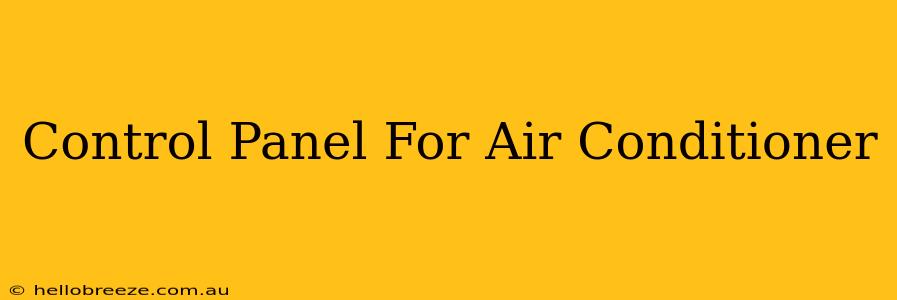Air conditioner control panels are the brains of your cooling system, offering a gateway to comfort customization. Understanding its features empowers you to optimize performance and energy efficiency. This guide explores the various components, functionalities, and troubleshooting tips for different types of AC control panels.
Understanding Your AC Control Panel: A Quick Overview
Whether you have a wall-mounted unit, a window AC, or a sophisticated central air system, your control panel is the interface to manage its operations. Most panels share common elements, though complexity varies based on the model and features. Common features include:
Key Control Panel Components:
- Power Button: The most basic function – on or off.
- Mode Selection: Allows you to choose between cooling, heating (if applicable), fan-only, or auto modes.
- Temperature Setting: Adjusts the desired room temperature.
- Fan Speed Control: Lets you set the fan to low, medium, high, or auto.
- Timer: Programs the AC to turn on or off at specific times.
- Swing/Direction Control: (Often found in split-system ACs) Adjusts the direction of airflow.
- Energy Saving/Eco Mode: Optimizes energy consumption while maintaining a comfortable temperature.
- Sleep Mode: Gradually increases the temperature overnight for better sleep and energy saving.
- Filter Change Indicator: Alerts you when it's time to clean or replace the air filter.
Types of Air Conditioner Control Panels
The design and features of your air conditioner control panel depend largely on the type of system.
1. Window Air Conditioner Control Panels:
Typically simple and straightforward, offering basic functions like power, temperature setting, fan speed, and mode selection.
2. Split-System Air Conditioner Control Panels:
These panels are often more sophisticated, incorporating features like swing control, timers, multiple fan speeds, and potentially smart home integration. They usually include both an indoor and an outdoor unit, with the control panel residing indoors.
3. Central Air Conditioner Control Panels:
Often integrated into a thermostat, these control panels offer advanced features like programmable scheduling, zoning control (for multi-zone systems), humidity control, and advanced energy-saving settings. These systems are commonly connected to smart home systems for remote control and monitoring.
Troubleshooting Common Control Panel Issues
If you are experiencing problems with your AC control panel:
- No Power: Check the circuit breaker and power cord.
- Incorrect Temperature: Ensure the temperature setting is accurate and the unit is functioning correctly.
- Fan Not Working: Check the fan speed setting and ensure there are no obstructions.
- Error Codes: Consult your AC's manual for explanations of any error codes displayed.
- Unresponsive Buttons: Try cleaning the control panel and replacing batteries (if applicable).
If the problem persists, contact a qualified HVAC technician for repair.
Choosing the Right Control Panel for Your Needs
When selecting an air conditioner, consider the features you need and the size of your space. A larger room may require an AC with more cooling capacity and possibly more advanced control features. Smart home integration is also a worthwhile consideration for added convenience and energy-saving capabilities.
Keywords: Air conditioner control panel, AC control panel, air conditioner thermostat, AC thermostat, window AC control, split system AC control, central AC control, troubleshooting AC control panel, smart AC control panel, energy efficient AC control, AC control panel features, choosing an AC control panel.

